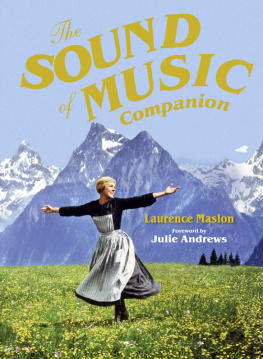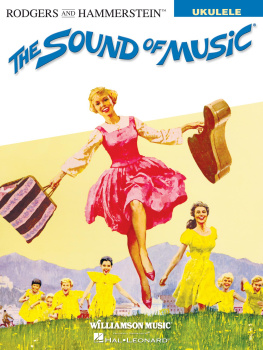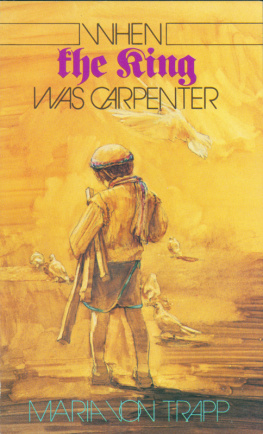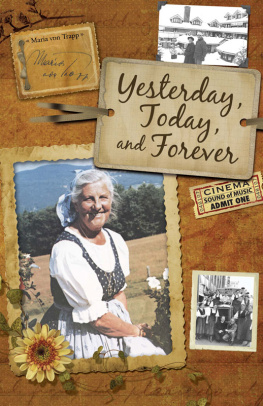
Maurice Zuberanos storyboard sketch for the opening of the film.


A smashing representation of the wedding scene for The Sound of Music from the Moscow Youth Stage (MDM) production from 2011.
To Ted Chapin and Bert Fink,
for their support and for their stewardship of
The Rodgers & Hammerstein Organization,
where the halls are alive with the sound of music.
LM.

The von Trapp Family, happily arrived in America, after their first singing tour, 1939. Maria and Georg von Trapp (center) welcome Johannes, the only American-born addition to the family.
CONTENTS
FOREWORD

I n the spring of 1962, I had just finished a long run on Broadway as Queen Guenevere in Camelot and CBS decided to take a gamble and produce an evening of music and comedy at Carnegie Hall featuring my good chum, Carol Burnett and myself. One of the sketches in our show was called The Swiss Family Pratt about an impossibly large family of Tyrolean folk singers. It was a spoof, of course, on The Sound of Music. The musical had opened in 1959 and was still running on Broadway, to great success. But it had a reputation for being somewhat saccharine, so it was ripe for being spoofed. And, oh, we had fun! We thought we were being so cleverbut, of course, I had no idea at the time that one day I would be in the film production of The Sound of Music! That CBS television show has come back to haunt me many times since.
When I was first asked if I would consider the role of Maria von Trapp, I was thrilled. But just for a moment I questioned, after having played one nanny in Mary Poppins, whether playing another nanny would be a good idea. Yet it was such a delicious role. And the score, written by Richard Rodgers and Oscar Hammerstein, who had created Cinderella on television for me, had such beautiful music. I happily acceptedand thus began an adventure, an education and an experience for me that I will always hold dear to my heart.
Mary Rodgers, Richard Rodgers daughter, once said to me that The Sound of Music was one of her fathers shows that turned out to be better on the screen than it was on the stage. Sometimes when musicals from Broadway are adapted to film, they become slightly glossy or manufactured. In the case of The Sound of Music, it did indeed transcend the original production. However, I dont think any of us who were involved in the film could have anticipated its phenomenal success.
Im often asked why this film has remained so astonishingly popular after all these years. Im not sure there is any one answer. Ultimately, I think the audience comes away with a sense of joy. First and last, it is about family...and there is the glorious scenery. It was a huge undertaking to move cast and crew to various locations in Salzburg, where the real von Trapp story began. Theres no doubt that it gave an indescribable look to the film. Oddly, no one mentioned at the time that Salzburg has Europes seventh highest annual rainfall! It certainly rained a lot that summer and many of those beautiful outdoor scenes were shot during a light drizzle, or we sat and waited endless hours under tarpaulins for the sun to come out. The weather delayed our schedule by roughly three weeks, but as Robert Wise, our director, said, those huge cumulus clouds captured on film gave a subliminal sense of strength and wonder.
One essential aspect of the films success was that everyone involved was at the peak of their craftfrom screenwriter Ernest Lehman to cinematographer Ted McCord, our associate producer Saul Chaplin (who did so much to preserve the quality of music and sound), to costumer Dorothy Jeakins, designer Boris Leven, choreographers Mark and Dee Dee Breaux, and the thrilling orchestrations by Irwin Kostal. Robert Wises firm yet gentle direction gave us a vision that was unfailing and true. What a lovely legacy we have of the subtle craft that is Hollywood at its best.
I havent even mentioned the delight of working with Christopher Plummer and those SEVEN children! Yes, I adored them all and we remain friends to this day. Christopher brought such strength to the filmand an astringent quality that helped so much to dissipate that potential saccharine I mentioned earlier. He and I remain great friends and, in fact, have worked twice more together over the years.
Surely the films success has a lot to do with the glorious music and words of Richard Rodgers and Oscar Hammerstein. Anyone singing those beautiful songs cant help but soar and be transported.
The Sound of Music is about youth and children and singing and music and mountains and the real joy that all of us felt while making it.
How lucky can a girl get to have been a part of it all.
Julie Andrews
June, 2014
INTRODUCTION
M any of the worlds great musicals arent based on stories that automatically sound like brilliant ideas. A flower girl transformed by an emotionally distant professor into a woman acceptable to society? Romeo and Juliet reimagined as the story of a New York City gang war? A Welsh woman sent to a foreign country to teach the multitudinous children of the ruler? A beautiful young opera singer lured into the dark lairs beneath a haunted opera house? A would-be nun sent to be a temporary nanny to the children of an ex-naval officer?
But it is due to the magic of musical theater that these all served as the bases for classics. And this last ideaa true story, as it happensprompted the creation of what has become the most beloved musical of all time. This book tells how that musical came to be, how it thrives on stages and movie screens around the world, and how its legacy has continued for nearly half a century with no sign of slowing down. That musical is, of course, The Sound of Music.
The success of The Sound of Music is nothing short of extraordinary. Audiences began embracing it during its pre-Broadway engagements in New Haven and Boston in 1959. It ran on Broadway successfully and went out across the United States on many long tours. It was mounted in London, where for many years it held the record as the longest-running American musical in that city. Thus began its peregrinations around the globe, where it has appeared in productions large and small ever since. And of course, there is that movie Made by 20th Century Fox in 1965, it is, by any estimation, the most successful movie musical in history.
Rodgers and Hammerstein were masters at creating musicals in which characters face their own lives and problems with honesty and clarity. The composer (Richard Rodgers) and the lyricist (Oscar Hammerstein II) were such a unified team that their work comes across almost as a single expressiontry looking at the words for Do Re Mi and not hearing the melody that was composed to go with them, for example. The fact that they wrote five of the worlds most cherished stage musicals (
Next page
















